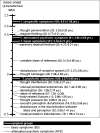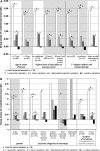Basic symptoms and ultrahigh risk criteria: symptom development in the initial prodromal state
- PMID: 18579555
- PMCID: PMC2800137
- DOI: 10.1093/schbul/sbn072
Basic symptoms and ultrahigh risk criteria: symptom development in the initial prodromal state
Abstract
Symptom development during the prodromal phase of psychosis was explored retrospectively in first-episode psychosis patients with special emphasis on the assumed time-related syndromic sequence of "unspecific symptoms (UN)-predictive basic symptoms (BS)-attenuated psychotic symptoms (APS)-(transient) psychotic symptoms (PS)." Onset of syndromes was defined by first occurrence of any of their respective symptoms. Group means were inspected for time differences between syndromes and influence of sociodemographic and clinical characteristics on the recalled sequence. The sequence of "UN-BS/APS-PS" was clearly supported, and both BS and, though slightly less, APS were highly sensitive. However, onset of BS and APS did not show significant time difference in the whole sample (N = 126; 90% schizophrenia), although when each symptom is considered independently, APS tended to occur later than first predictive BS. On descriptive level, about one-third each recalled an earlier, equal and later onset of BS compared with APS. Level of education showed the greatest impact on the recall of the hypothesized sequence. Thereby, those with a higher school-leaving certificate supported the assumed sequence, whereas those of low educational background retrospectively dated APS before BS. These findings rather point out recognition and recall bias inherent to the retrospective design than true group characteristics. Future long-term prospective studies will have to explore this conclusively. However, as regards the criteria, the results support the notion of BS as at least a complementary approach to the ultrahigh risk criteria, which may also allow for an earlier detection of psychosis.
Figures



References
-
- Yung AR, Phillips LJ, McGorry PD, et al. Prediction of psychosis. Br J Psychiatry. 1998;173(suppl 33):14–20. - PubMed
-
- Phillips LJ, Yung AR, McGorry PD. Identification of young people at risk of psychosis: validation of Personal Assessment and Crisis Evaluation Clinic intake criteria. Aust N Z J Psychiatry. 2000;34(suppl):S164–S169. - PubMed
-
- Schultze-Lutter F. Prediction of psychosis is necessary and possible. In: McDonald C, Schultz K, Murray R, Wright P, editors. Schizophrenia: Challenging the Orthodox. London, UK: Taylor & Francis; 2004. pp. 81–90.
-
- Klosterkötter J, Hellmich M, Steinmeyer EM, Schultze-Lutter F. Diagnosing schizophrenia in the initial prodromal phase. Arch Gen Psychiatry. 2001;58:158–164. - PubMed
-
- Ruhrmann S, Schultze-Lutter F, Klosterkötter J. Early detection and intervention in the initial prodromal phase of schizophrenia. Pharmacopsychiatry. 2003;36(suppl 3):162–167. - PubMed
Publication types
MeSH terms
LinkOut - more resources
Full Text Sources
Medical
Miscellaneous

